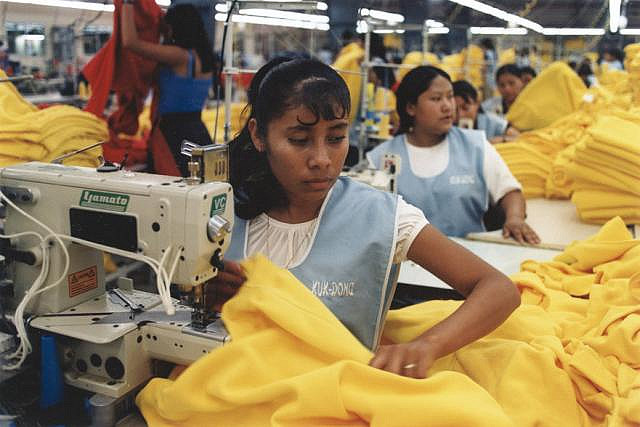Huffington Post has an article titled “The Myth of the Ethical Shopper,” which explores how changes in the garment industry over the past twenty-five years or so have undermined efforts to eliminate sweatshops and other labor abuses.
It all started in the mid-’90s, when anti-sweatshop mania burst into the mainstream of American culture. Naked people chanted outside the opening of an Old Navy, Jennifer Love Hewitt led an anti-sweatshop protest on “Party of Five,” Kathie Lee Gifford cried in front of Congress. Nearly every major apparel brand was, at one point or another, the target of a boycott campaign. Radiohead told its millions of fans to read No Logo, Naomi Klein’s investigative polemic against multinational corporations.
And for a while there, it worked. The major apparel companies adopted codes of conduct, first banning just the most egregious stuff—workers under 16, forced overtime—then expanding to health and safety, environmental protection and social investment. Since 1998, Nike has followed U.S. clean air standards in all of its factories worldwide, while Levi’s gives financial literacy classes to some of its seamstresses. Every company from Hanes to Halliburton has a social responsibility report. An entire ecosystem of independent inspectors and corporate consultants has sprung up, applying auditing standards that are as pedantic and uncompromising as the NGOs advocating for them.
But in the past 25 years, the apparel industry, the entire global economy, has undergone a complete transformation. The way our clothes are made and distributed and thrown away is barely recognizable compared to the way it was done in the ’90s. And yet our playbook for improving it remains exactly the same.
Driving this change is the ever-faster production cycle required by current merchandising strategies;
We buy more clothes now, move through trends faster. In the olden days—the early ‘90s—brands produced two to four fashion cycles per year, big orders coordinated by season, planned months in advance. These days, there’s no such thing as cycles, only products. If a shirt is selling well, Wal-Mart orders its suppliers to make more. If headbands inexplicably come into fashion, H&M rushes to make millions of them before they go out again.
This flexibility means that factories have to compete on the number of clothing lines they can produce and how quickly they can switch from one to another…
In the fast-fashion era, Western brands can’t afford the luxury of working with the same suppliers and ensuring that they meet the company’s standards. And so, rather than manage a giant, respirating network of factories themselves, most of them have outsourced this coordination to megasuppliers: huge conglomerates that can take a design sketch, split the production between thousands of factories, box up the goods and ship them to stores in less time than they’ll stay in style.
But an even bigger driver is the growing prosperity in previously impoverished nations where many of our clothes are made. As the markets in the developing world grow larger, Western markets (and Western standards) have waning influence.
Factories in developing countries that send clothes to export markets need to at least look like they’re complying with social standards. For domestic markets, they don’t.
Maybe even more than the other reasons I’ve outlined, this is why consumer advocacy campaigns are never going to improve working conditions in the developing world: Western markets simply don’t matter as much as they used to. India produces twice as much clothing for its own consumers as it does for us. Fifty-six percent of the clothing produced in China is for the Chinese market. Both of those numbers are only going to grow.
The article suggests that if we are serious about eliminating things like sweatshops and child labor, we should focus on empowering and supporting local governments in their own enforcement (many such abuses are illegal in the developing world as well) and by lobbying for changes in our own national policies on imports.
Listening to consumer advocacy campaigns, you’d think our only influence on the developing world was at the cash register. But our real leverage is with our policies, not our purchases. In the ’90s, the U.S. told Cambodia that to sell its clothes here, it had to open up every single garment factory to International Labor Organization inspections. Trade agreements require developing countries to establish huge intellectual-property inspection bodies to raid markets for bootleg Blu-rays. We just need to offer poor workers the same kinds of protection we give pharmaceutical patents.
As for Western companies, we shouldn’t let them off the hook. But let’s be clear: All of those emerging-market multinationals that South Korea and China are sending abroad have operations in the United States, too. Foxconn has a factory in Indiana. It is not a sweatshop. That isn’t because Foxconn carries out such great audits or offers entrepreneurship classes. It’s because it is located in a country with functioning institutions.
posted by Jon White
image: By marissaorton (Sweatshop project Uploaded by Gary Dee) [CC BY-SA 2.0 (http://creativecommons.org/licenses/by-sa/2.0)], via Wikimedia Commons

